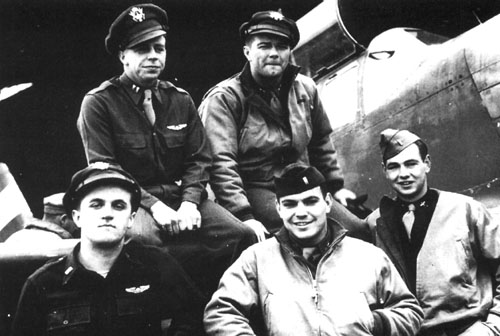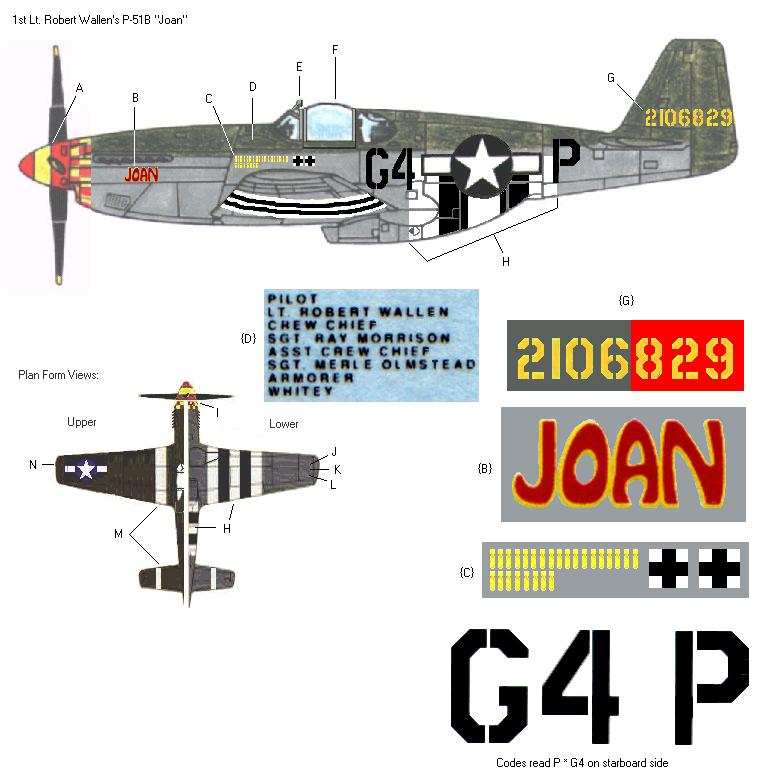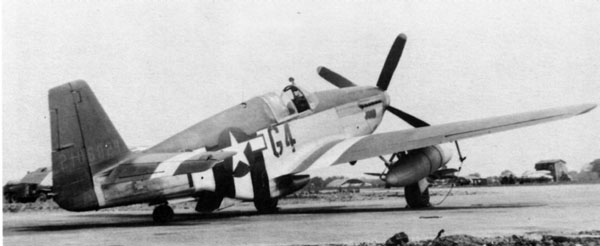357th FG Profile

Bob Wallen (Front/left) pilot of “Joan” with other stalwarts of the original 362nd FS. Joe Broadhead, Dave Perron, Ken Hagan and Arval Roberson.

Summer, 1944
Modeler Tips:
A. Rear red band on propeller boss extends onto spinner to leading edge of blades when in neutral pitch. Determine width of yellow band by dividing remainder of spinner evenly.
B. “JOAN” in lettering lettering is red, outlined in yellow on lower strip panel- note position relative to exhausts.
C. 26 yellow bomb-style mission marks, 18 above and 8 beneath. Two large bold black crosses over white square background.
D. Black stencil listing pilot and ground crew names on reservoir cover.
E. RAF style round mirror on pylon mount.
F. Retro-fitted Malcolm Canopy, curved frames in natural aluminum with green side rails.
G. Tail number in yellow- “2106” on fin, “829” on rudder.
H. Reduced invasion stripes, on both wings and fuselage.
Planform View Notes:
H. Same as item ” H”, above.
I. Width of checker reduced on underside in order to fit evenly on the narrow surfaces of the chin scoop area. J, K, L. Red, Green, Yellow navigation lights- circular and flush with wing panel.
M. White recognition stripes on upper surfaces of wings and horizontal stabilizers.
N. Formation Lights- Red (Port) and Green (Starboard)
Overall Modeling Tips:
*This aircraft had olive drab upper surfaces, natural metal underneath. Paint on the flat colors first (invasion stripes, recognition bands, camouflage areas, yellow nose band)- then mask off and paint remainder a natural aluminum color. Most metal colors will be marred or removed by masking materials so it’s often better to leave them for last.
*Okay, now a few notes about this aircraft. “JOAN” was a long-serving P-51B with the 357th and therefore has been photographed in several combinations of markings. This profile shows her as she would have appeared a few weeks after D-Day. For the immediate Overlord period, use full wrap-around invasion stripes as on Bud Anderson’s “Old Crow” P-51B, remove up to eight mission marks, and install a standard issue framed three-piece “B” model canopy and straight antenna mast, paint aircraft in half green-half aluminum scheme. From the Spring of 1944 until the evening of June 5th she wore the regular Dark Olive Green over USAAC Light Grey with white recognition bands and had a standard-issue framed three-piece canopy. Prior to going two-tone her kill marks were black swastikas on white circles. She appeared as in the profile during the autumn of ’44 except that by then the mission marks had filled in the bottom row out to the first kill mark. Some decal manufacturers have indicated that she had a red rudder, but this is believed by several 357th FG Alumni and other authorities on the matter to have been an error.
*After building several 357th A/C over the past 30 years, I recommend painting the nose area forward of the exhaust cutout yellow when the flat features are painted. Carefully cut away the yellow squares from the checkerboard decal and apply the remaining strip of red checkers to the nose. This method significantly reduces the potential for bubbles, and wrinkles plus it makes exact alignment of the decal easier.
*Prior to assembly, wash clear plastic parts with a mild glass cleaner and gently wipe dry. Then use a Q-Tip to evenly spread clear liquid floor wax (Future Brand seems to get the best results) on both inside & outside. Protect from dust and let dry for at least 2 hours. The wax fills in microscopic flaws and creates an even gloss that is clearer & shines brighter than the original plastic underneath.

1st Lt. Robert Wallen’s P-51B Mustang “Joan”
Repli-Scale Decal Sheet 48-5056

